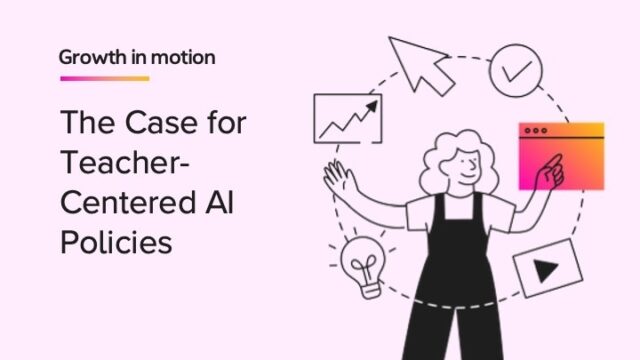
While the pandemic has created new challenges in the classroom, one bright spot, according to HMH's latest Educator Confidence Report, is that teachers are feeling more confident than ever using technology. This includes artificial intelligence, or AI, which is helping teachers provide ongoing assessment, drive instruction, and find more time to focus on what matters most: their students.
Access to AI for all students has grown over the last few years. HMH General Manager of Supplemental and Intervention Solutions and EdTech expert Matthew Mugo Fields finds this news encouraging.
“A connected device is an essential learning instrument, not just a nice-to-have for those who can afford it or for districts that embrace technology,” he says. “It's good to see that our government has created funding streams to ensure that many of the students who lacked those devices now have access to them.”
As the accessibility of technology in the classroom increases, the opportunity to benefit from AI is expanding in 2022 and beyond.
Artificial Intelligence Benefits in Education
As AI evolves and becomes more widespread, it has become an assistant to teachers. Fields explains, “AI can help educators accurately understand what students know and don’t know—and what they are ready to learn next.”
In this way, AI can help to inform instruction and personalize learning—in addition to saving teachers precious time. Below, we’ll delve into four key advantages of AI in education for both teachers and students.
Personalized Learning
Programs that use AI offer advantages, such as custom feedback, in order to personalize instruction for each learner.
For example, the Writable program features an AI engine that can check writing and offer revision suggestions to students. Similarly, Waggle tracks progress in skills and standards, collecting data to give teachers a comprehensive look at student progress. These results can then inform educators which subject areas they should focus on during class.
Over time, AI programs learn how individual students perform and personalize learning for them. Students can focus on their own specific learning gaps rather than follow a standardized plan.
Saves Teachers Time
The primary advantage of AI is that it saves time. This allows teachers to build better classroom communities and stronger student relationships.
“Good AI does tasks like running records that deliver an assessment…[which] means the teacher actually gets to spend their time on key issues like having more one-on-one interaction with students or with student groups,” says Brett Jenkins, Senior Vice President of Product Management at HMH and an expert in learning-technology solutions. “So the idea here is not replacing the teacher but actually adding capacity to teaching activities.”
For instance, by using Amira Learning–a one-on-one tutoring program for oral reading fluency–the time a teacher normally spends doing an oral-fluency assessment can instead be dedicated to one-on-one instruction and building meaningful connections with students.
“Oral reading fluency is a big predictor of overall literacy levels and skill development,” says Fields. “Assessment can take teachers 40 to 60 hours a year…sometimes even more than that. With [AI], you can do that work in a matter of minutes.”
Amira's dyslexia screener can also screen an entire class for dyslexia risk in less than 10 minutes. The results identify students who should be given a diagnostic assessment and targeted learning support. This early awareness can be life-changing for students with learning differences, and the rapid screening can help students get the intervention they need faster.
AI Advantages for Students
Boosts Students' Confidence
Yet another educational advantage of AI: the undivided attention it provides for a learner’s specific needs can boost student confidence.
“There's a concept in psychology called the mere presence effect, which basically says if you're doing something easy in front of somebody, you'll generally do it a little bit faster than if you were doing it alone,” says Jenkins. “If you're doing something hard, you'll do poorly, and it's just because you feel like you're being judged.”
By providing private feedback and instruction, the AI software in Amira removes the intimidation factor. This benefits students who have difficulties responding to an instructor or to a group of peers.
Amira also has a frustration index that marks how the student is faring with a lesson, and adjusts the lesson so that a student doesn’t get discouraged.
"Amira can sense the student’s disengagement or frustration in the session and adjust the amount of intervention so that it’s targeting patterns, but not overwhelming the kids,” says Jenkins.
When student anxiety and frustration are reduced, students have more positive learning experiences, which in turn leads to better student outcomes.
Addresses Human Bias
AI also focuses on raw student data without undue favor or judgment. “There's no bias into who the student is,” says Jenkins. “It's only targeting where the kid is in their learning journey, not who they are and their geography or zip code.”
However, as AI continues to develop, vigilance is also required to assure that harmful biases are not introduced or learned by the technology itself.
“We need to be careful [about how] these programs are actually trained, and what assumptions are being made about different students,” says Fields. “Making sure we're avoiding having AI systems carry forward some of the unfortunate biases that some humans carry is important.”
Final grading is also always left up to the teacher. Over the course of the school year, teachers naturally develop a better understanding for each of their students, and therefore develop empathy that can benefit individual students when it comes to subjective grading. Especially during times of high stress for students, a bit of personal understanding can go a long way.
Conclusion
Ultimately, AI in the classroom will continue to serve the purpose that it was always meant to—as an assistant to the teacher. This ever-evolving technology provides teachers and students with advantages that save time, leaving more space to develop the relationships that make a classroom community memorable.
***
Check out the AI-powered Amira Learning, an intelligent reading assistant that improves students' oral reading fluency. You can get a free demo here.
Streamline feedback and grow great writers with Writable. Scaffold student practice, increase engagement, and connect writing directly to your daily instruction. Request a free demo here.
Explore how Waggle personalizes practice in math and ELA to help students in Grades K–8 thrive. Request a self-guided demo.
Discover best practices for integrating AI in the classroom.














